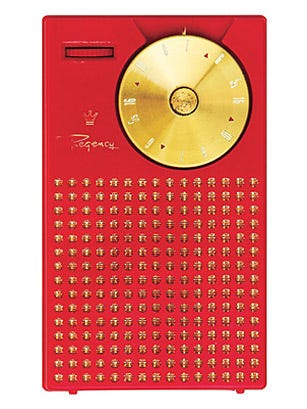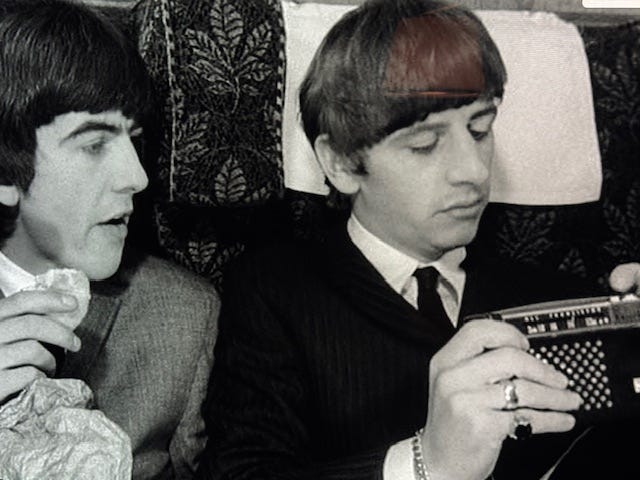How the Hot Christmas Gift of 1963 Created The Most Legendary Band of All Time
Musical and technological innovation are intrinsically linked. Those innovations accidentally intersected under the trees of 1963.
15-year-old Marsha Albert was watching the CBS Evening News with Walter Cronkite, as one did on a Tuesday night in 1963. A story from the network’s London bureau grabbed her attention: A Liverpool rock ‘n’ roll band was generating crazy fandom among young British people. It was a light-heated, if not sarcastic, segment about a sure to be short-lived fad.
CBS was going to air the segment on November 22nd, but events in Dallas killed that plan. By December 10th, Cronkite figured America needed something frivolous after several weeks processing the Kennedy assassination. The five-minute piece that ended Tuesday’s news included an interview with the group, a look inside their fan club, and a performance of their current smash, “She Loves You.”
The adults watching Walter Cronkite that night marveled at those crazy kids and their fads. One of those squares was Ed Sullivan, who booked “those bugs or whatever they call themselves,” for his show in February.
Marsha Albert heard something completely different.
She really liked their performance of “She Loves You.” It sounded so fresh and exciting to her. She wrote to Carroll James, the afternoon DJ at 1260 WWDC. (It wasn’t even a rock ‘n’ roll station, but it was the only one the teenager could pick up on her cheap radio in her bedroom in Silver Spring, Maryland.)
“Why can't we have music like that here in America?"
Carroll James agreed, having also seen Walter Cronkite that night, as one did back then. He arranged for a stewardess (as they were called back then) for British Overseas Airways Corporation (as they were called back then) to buy a copy of their latest single in England and fly it to him in Washington.
A week later, on December 17th, 1963, Carroll invited Marsha to the station to personally introduce the Beatles’ “I Want To Hold Your Hand.”
The phones went wild. Listeners wanted to hear it again and again.
Later that night, Carroll James dubbed a tape of his show featuring the song and mailed it to fellow radio personalities in Chicago and St. Louis. They played the song right off the tape, where listeners also went wild.
Capitol Records was livid.
They hadn’t planned on releasing “I Want to Hold Your Hand” until February. Thinking the Beatles would surely be a short-lived fad that they didn’t want to miss, Capitol Records rushed the new single to stores, where it would go on sale on the unusual release date of December 26th.
That’s the legend of how Beatlemania started in America and—in the process—helped us heal from President Kennedy’s assassination.
As there usually is, there’s much more to the story than the tale tells, such as how several U.S. radio stations had already played the Beatles throughout 1963. (I touched on that saga in this post.) No one cared.
Or, how the hottest Christmas gift of 1963 played a pivotal role in fueling Beatlemania.
The Tech Revolution of the Rock ‘n’ Roll Era
Nine years earlier, the world’s first transistor radio debuted just in time for Christmas 1954. A radio in your pocket—a modern miracle! Reviewers noted it was a pretty crappy performer. Wasn’t loud. Only picked up strong stations.
It also wasn’t something you bought for your kids: The Regency TR-1 cost $590 in 2024 money.
Contrary to tales of teens discovering Elvis Presley and Buddy Holly on transistor radios, teens more typically heard those early rock ‘n’ rollers on an old vacuum tube table radio mom and dad didn’t use once they got the family TV. The transistor radio remained an expensive luxury into the early 1960s.
This 1962 Sony TR-817 from my personal collection came as a boxed gift set worthy of a YouTube unboxing. Even today, it’s a damn good AM radio. Costing the equivalent of $415 in 2024, it was the gift you got for making mid-American manufacturing salesman of the year—not the one you bought your 12-year-old.

That changed in 1963.
From Tech Marvel to Everyday Companion
Thanks to maturing technology and cheap labor in Hong Kong, you could pick up a transistor radio for just $7.99, around 80 bucks today. While only 5.5 million transistor radios sold from 1954 through 1962, 10 million sold in 1963 alone.
The transistor radio was the #1 Christmas gift of 1963.
So ubiquitous was it under the tree that year that it inspired the parody song “The Twelve Gifts of Christmas,” with its “Japanese transistor radio.”
It was in the mid 1960s—not the 1950s—that the transistor radio became the ubiquitous companion of young America.
The Song Every Kid Heard on Their New Christmas Gift
It’s the day after Christmas. You’re a teenager, listening to your brand-new transistor radio. That earphone’s in your ear for hours. (Even on school days, the typical teenager listened to the radio for three hours a day back then.)
And the song you hear over and over? “I Want to Hold Your Hand.”
With Uncle Elmar’s Christmas cash in hand, you go to Montgomery Ward and buy one of the 250,000 copies of the new Beatles record sold in the first three days after Christmas.
By the time The Beatles arrived in New York for the Ed Sullivan show, the rabid teens of the tri-state descended on the Plaza hotel where the fab four stayed. During their second U.S. visit, the Beatles were at the Delmonico Hotel while 10,000 teenagers gathered outside. They all had their transistor radios with them tuned to Musicradio 77 WABC. So when disc jockeys Scott Muni and “Cousin Brucie” Bruce Morrow asked them to sing the WABC jingle, all 10,000 sang the call letters in unison.
The myriad coincidences that launched American Beatlemania, from the Kennedy Assassination to Ed Sullivan, are now enshrined in Rock lore. However, the coincidence of the transistor radio being the hottest Christmas gift of 1963—fueling sales of the future #1 single Capitol Records had to release on December 26th—is a part of the story that deserves to be a bigger part of that tale.
Happy Holidays To You!
Thank you for being a part of Graphs About Songs this year! It’s a priceless gift to me that you’re sharing this circuitous journey through popular music with me!
I’ll be back in January to turn the music that stirs your soul into PowerPoint charts. (I’ll keep publishing The Hit Momentum Report every Monday for the professional music programmers among you who subscribe.)
Sources for this post:








